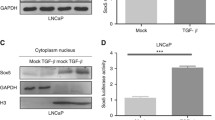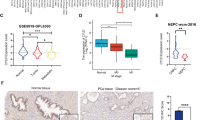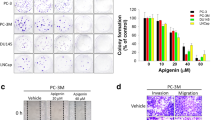Abstract
Prostate cancer (PCA) is an epithelial malignant tumor occurring in the prostate gland. It is the second most common male cancer in the world and one of the top five cancer deaths in men. To combat this disease, it is needed to identify important tumor suppressor genes and elucidate the molecular mechanisms. S100 calcium-binding protein A14 (S100A14), a member of the S100 family, is located on chromosome 1q21.3 and contains an EF-hand motif that binds calcium. S100A14 is involved in a variety of tumor biological processes in several types of cancers. Its expression level and related biological functions are tissue or tumor specific. However, its possible effects on prostate cancer are still unclear. Herein, we found the low expression of S100A14 in human prostate cancer tissues and cell lines. S100A14 suppressed the proliferation of prostate cancer cells and promoted cell apoptosis. Additionally, S100A14 suppressed the motility and EMT processes of prostate cancer cells. We further found S100A14 promoted the expression of FAT1 and activated the Hippo pathway, which, therefore, suppressed the prostate cancer progression. The in vivo assays confirmed that S100A14 suppressed tumor growth of prostate cancer cells through FAT1-mediated Hippo pathway in mice. In conclusion, we clarified the mechanism underlying S100A14 suppressing prostate cancer progression and, therefore, we thought S100A14 could serve as a tumor suppressor protein.






Similar content being viewed by others
Availability of data and materials
All data generated or analyzed during this study are included in this published article.
References
Bland T, Wang J, Yin L, Pu T, Li J, Gao J, et al. WLS-Wnt signaling promotes neuroendocrine prostate cancer. iScience. 2021;24(1):101970. https://doi.org/10.1016/j.isci.2020.101970.
Zhang Y, Wang Y, Meng L, Huang Q, Zhu Y, Cui W, et al. Targeted micelles with chemotherapeutics and gene drugs to inhibit the G1/S and G2/M mitotic cycle of prostate cancer. J Nanobiotechnol. 2021;19(1):17. https://doi.org/10.1186/s12951-020-00756-6.
Heidegger I, Necchi A, Pircher A, Tsaur I, Marra G, Kasivisvanathan V, et al. A systematic review of the emerging role of immune checkpoint inhibitors in metastatic castration-resistant prostate cancer: will combination strategies improve efficacy? Eur Urol Oncol. 2020. https://doi.org/10.1016/j.euo.2020.10.010.
Vlajnic T, Bubendorf L. Molecular pathology of prostate cancer: a practical approach. Pathology. 2021;53(1):36–43. https://doi.org/10.1016/j.pathol.2020.10.003.
Tremblay M, Viala S, Shafer ME, Graham-Paquin AL, Liu C, Bouchard M. Regulation of stem/progenitor cell maintenance by BMP5 in prostate homeostasis and cancer initiation. Elife. 2020. https://doi.org/10.7554/eLife.54542.
Pietas A, Schluns K, Marenholz I, Schafer BW, Heizmann CW, Petersen I. Molecular cloning and characterization of the human S100A14 gene encoding a novel member of the S100 family. Genomics. 2002;79(4):513–22. https://doi.org/10.1006/geno.2002.6744.
Diamantopoulou A, Mantas D, Kostakis ID, Agrogiannis G, Garoufalia Z, Kavantzas N, et al. A clinicopathological analysis of S100A14 expression in colorectal cancer. In Vivo. 2020;34(1):321–30. https://doi.org/10.21873/invivo.11777.
Sugino T, Ichikawa-Tomikawa N, Tanaka M, Shishito N, Miura T, Abe M, et al. Identification of S100A14 as a metastasis-promoting molecule in a murine organotropic metastasis model. Clin Exp Metas. 2019;36(4):411–22. https://doi.org/10.1007/s10585-019-09979-w.
Li X, Wang M, Gong T, Lei X, Hu T, Tian M, et al. A S100A14-CCL2/CXCL5 signaling axis drives breast cancer metastasis. Theranostics. 2020;10(13):5687–703. https://doi.org/10.7150/thno.42087.
Bertini I, Borsi V, Cerofolini L, Das Gupta S, Fragai M, Luchinat C. Solution structure and dynamics of human S100A14. J Biol Inorg Chem JBIC. 2013;18(2):183–94. https://doi.org/10.1007/s00775-012-0963-3.
Zhu M, Wang H, Cui J, Li W, An G, Pan Y, et al. Calcium-binding protein S100A14 induces differentiation and suppresses metastasis in gastric cancer. Cell Death Dis. 2017;8(7):e2938. https://doi.org/10.1038/cddis.2017.297.
Al-Ashkar N, Zetoune AB. S100A14 serum level and its correlation with prognostic factors in breast cancer. J Egypt Natl Cancer Inst. 2020;32(1):37. https://doi.org/10.1186/s43046-020-00048-y.
Zhao H, Guo E, Hu T, Sun Q, Wu J, Lin X, et al. KCNN4 and S100A14 act as predictors of recurrence in optimally debulked patients with serous ovarian cancer. Oncotarget. 2016;7(28):43924–38. https://doi.org/10.18632/oncotarget.9721.
Ding F, Wang D, Li XK, Yang L, Liu HY, Cui W, et al. Overexpression of S100A14 contributes to malignant progression and predicts poor prognosis of lung adenocarcinoma. Thorac Cancer. 2018;9(7):827–35. https://doi.org/10.1111/1759-7714.12654.
Wang YY, Gao YX, Gao W, Xu Y, Xu YZ, Wang YJ, et al. Design, synthesis and biological evaluation of tricyclic diterpene derivatives as novel neuroprotective agents against ischemic brain injury. Eur J Med Chem. 2015;103:396–408. https://doi.org/10.1016/j.ejmech.2015.08.057.
Freytag M, Kluth M, Bady E, Hube-Magg C, Makrypidi-Fraune G, Heinzer H, et al. Epithelial splicing regulatory protein 1 and 2 (ESRP1 and ESRP2) upregulation predicts poor prognosis in prostate cancer. BMC Cancer. 2020;20(1):1220. https://doi.org/10.1186/s12885-020-07682-8.
Gomes LF, Longhi PJH, Machado L, da Cruz IBM, Montano MAE, Martins M, et al. Lemongrass (Cymbopogon citratus (D.C.) Stapf) presents antitumoral effect and improve chemotherapy activity in prostate cancer cells. Anti-Cancer Agents Med Chem. 2021. https://doi.org/10.2174/1871520621666210112111711.
O’Dwyer E, Bodei L, Morris MJ. The role of theranostics in prostate cancer. Semin Radiat Oncol. 2021;31(1):71–82. https://doi.org/10.1016/j.semradonc.2020.07.004.
Chakravarty D, Huang L, Kahn M, Tewari AK. Immunotherapy for metastatic prostate cancer: current and emerging treatment options. Urol Clinics N Am. 2020;47(4):487–510. https://doi.org/10.1016/j.ucl.2020.07.010.
Meng DF, Sun R, Liu GY, Peng LX, Zheng LS, Xie P, et al. S100A14 suppresses metastasis of nasopharyngeal carcinoma by inhibition of NF-kB signaling through degradation of IRAK1. Oncogene. 2020;39(30):5307–22. https://doi.org/10.1038/s41388-020-1363-8.
Pandey S, Osman TA, Sharma S, Vallenari EM, Shahdadfar A, Pun CB, et al. Loss of S100A14 expression at the tumor-invading front correlates with poor differentiation and worse prognosis in oral squamous cell carcinoma. Head Neck. 2020;42(8):2088–98. https://doi.org/10.1002/hed.26140.
Wang HY, Zhang JY, Cui JT, Tan XH, Li WM, Gu J, et al. Expression status of S100A14 and S100A4 correlates with metastatic potential and clinical outcome in colorectal cancer after surgery. Oncol Rep. 2010;23(1):45–52.
Sapkota D, Costea DE, Blo M, Bruland O, Lorens JB, Vasstrand EN, et al. S100A14 inhibits proliferation of oral carcinoma derived cells through G1-arrest. Oral Oncol. 2012;48(3):219–25. https://doi.org/10.1016/j.oraloncology.2011.10.001.
Wang Y, Jia A, Cao Y, Hu X, Wang Y, Yang Q, et al. Hippo kinases MST1/2 regulate immune cell functions in cancer, infection, and autoimmune diseases. Crit Rev Eukaryot Gene Expr. 2020;30(5):427–42. https://doi.org/10.1615/CritRevEukaryotGeneExpr.2020035775.
Wang X, Ji C, Hu J, Deng X, Zheng W, Yu Y, et al. Hsa_circ_0005273 facilitates breast cancer tumorigenesis by regulating YAP1-Hippo signaling pathway. J Exp Clin Cancer Res CR. 2021;40(1):29. https://doi.org/10.1186/s13046-021-01830-z.
Chen Q, Zhou XW, Zhang AJ, He K. ACTN1 supports tumor growth by inhibiting Hippo signaling in hepatocellular carcinoma. J Exp Clin Cancer Res CR. 2021;40(1):23. https://doi.org/10.1186/s13046-020-01821-6.
Xu W, Zhang M, Li Y, Wang Y, Wang K, Chen Q, et al. YAP manipulates proliferation via PTEN/AKT/mTOR-mediated autophagy in lung adenocarcinomas. Cancer Cell Int. 2021;21(1):30. https://doi.org/10.1186/s12935-020-01688-9.
Sadeqzadeh E, de Bock CE, Zhang XD, Shipman KL, Scott NM, Song C, et al. Dual processing of FAT1 cadherin protein by human melanoma cells generates distinct protein products. J Biol Chem. 2011;286(32):28181–91. https://doi.org/10.1074/jbc.M111.234419.
Morris LG, Kaufman AM, Gong Y, Ramaswami D, Walsh LA, Turcan S, et al. Recurrent somatic mutation of FAT1 in multiple human cancers leads to aberrant Wnt activation. Nat Genet. 2013;45(3):253–61. https://doi.org/10.1038/ng.2538.
Hu X, Zhai Y, Kong P, Cui H, Yan T, Yang J, et al. FAT1 prevents epithelial mesenchymal transition (EMT) via MAPK/ERK signaling pathway in esophageal squamous cell cancer. Cancer Lett. 2017;397:83–93. https://doi.org/10.1016/j.canlet.2017.03.033.
Funding
This work was supported by the Fujian Natural Sciences Foundation. (Grant no. 2017J01203), Joint Funds for the Innovation of Science and Technology, Fujian Province (Grant no. 2017Y9023) and Startup Fund for scientific research, Fujian Medical University (Grant no. 2018QH1044).
Author information
Authors and Affiliations
Contributions
SJ and YZ designed the study, supervised the data collection, SJ, ZC and ZH analyzed the data, interpreted the data, BL, YX, ZL, ZL and ML prepare the manuscript for publication and reviewed the draft of the manuscript. All authors have read and approved the manuscript.
Corresponding author
Ethics declarations
Conflict of interest
The authors state that there are no conflicts of interest to disclose.
Ethics approval
All procedures performed in studies involving human participants were in accordance with the standards upheld by the Ethics Committee of Fujian Medical University Union Hospital and with those of the 1964 Helsinki Declaration and its later amendments for ethical research involving human subjects (Approval No. 2020KY0112). All animal experiments were approved by the Ethics Committee of Fujian Medical University Union Hospital for the use of animals and conducted in accordance with the National Institutes of Health Laboratory Animal Care and Use Guidelines (Approval No. 2020-047).
Informed consent
Written informed consent was obtained from a legally authorized representative(s) for anonymized patient information to be published in this article.
Additional information
Publisher's Note
Springer Nature remains neutral with regard to jurisdictional claims in published maps and institutional affiliations.
Rights and permissions
About this article
Cite this article
Jiang, S., Zhu, Y., Chen, Z. et al. S100A14 inhibits cell growth and epithelial–mesenchymal transition (EMT) in prostate cancer through FAT1-mediated Hippo signaling pathway. Human Cell 34, 1215–1226 (2021). https://doi.org/10.1007/s13577-021-00538-8
Received:
Accepted:
Published:
Issue Date:
DOI: https://doi.org/10.1007/s13577-021-00538-8




